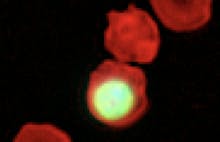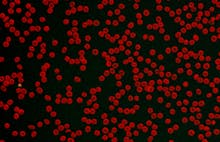Red Blood Cell Count
Definition, Low vs High Ranges and SymptomsWhat are red blood cells?
Every second, your bone marrow makes 2-3 million red blood cells.[1] Also called erythrocytes, red blood cells contain the protein hemoglobin that carries oxygen from the lungs to the tissues.
Red blood cells are the most common type of cell found in the blood. And it’s not surprising. The oxygen they carry is essential for cell metabolism.
In their mature state, red blood cells are small (only 6 µm) and biconcave in shape. When they pass through small blood vessels, they transform into a bell-like shape so that they can squeeze through.
As red blood cells mature in your bone marrow, they get rid of their nuclei. This extrusion of nuclei by mature red blood cells happens right before they leave the bone marrow. It creates more space for hemoglobin.
In people with certain medical conditions, red blood cells have abnormal shapes. For example, in individuals with pernicious anemia, red blood cells appear oval-shaped; and in sickle-cell anemia, crescent-shaped.
What is a red blood cell count?
A red blood cell count, also known as an erythrocyte count, calculates the number of red blood cells in your blood. It is typically measured as part of a complete blood count (CBC).
A red blood cell count is measured in millions per microliter (RBC X 106/µL) or millions per cubic millimeter (RBC X 106/mm3)
What is a low red blood cell count?
A low red blood cell count is a condition known as anemia.
There are three causes of anemia:
- Blood loss – due to wounds, lesions, ulcers, hemorrhoids, inflammation of the stomach, and cancers of the gastrointestinal tract.
- Faulty or decreased red blood cell production – due to sickle cell anemia, iron deficiency anemia, vitamin deficiency anemia, and diseases of the bone marrow and stem cells.
- Excessive destruction of red blood cells.
What causes a low red blood cell count?
A low red blood cell count can be a sign of many health problems, including:
- Vitamin B-12 or folate (vitamin B-9) deficiency – deficiencies in either of these vitamins cause megaloblastic anemia, a condition in which the bone marrow makes large, abnormal, immature red blood cells (megaloblasts). These abnormal red blood cells are too large to exit the bone marrow and supply tissues with oxygen.
- Stomach ulcers – the lining of the stomach can bleed if you have a stomach ulcer. The bleeding eventually causes anemia.
- Bleeding – loss of blood decreases the number of red blood cells, resulting in anemia.
- Lupus – patients with lupus may have dangerous decreases in the number of red and white blood cells.
- Hodgkin lymphoma – when lymphoma cells spread to the bone marrow, they can crowd out and inhibit the normal, healthy cells that make new red blood cells.
- Leukemia – leukemia cells can form in the bone marrow and crowd out healthy cells that make new red blood cells.
- Multiple myeloma – myeloma cells can interfere with the normal, healthy cells in the bone marrow that make new red blood cells. About 60%-70% of people with multiple myeloma have anemia at the time of their diagnosis.[2]
What are the symptoms of a low red blood cell count?
People with a low red blood cell count may experience the following symptoms:
- Paleness
- Fatigue
- Weakness
- Shortness of breath
- Headaches
- Dizziness, lightheadedness, or feeling like you are about to pass out
- Fast or irregular heartbeat
What is a high red blood cell count?
A high red blood cell count is a condition called polycythemia vera. If you have this medical condition, it means that your bone marrow is producing too many red blood cells. This can result in thickening of the blood, slow flow of blood, and eventually blood clots.
There are two types of polycythemia vera[3]:
- Primary polycythemia vera: caused by a genetic mutation in the Janus kinase (JAK2) gene.
- Secondary polycythemia vera: caused by low levels of oxygen in the blood for an extended period. This is known as acquired polycythemia. When your tissues are deprived of oxygen for a long time – a condition that doctors call generalized hypoxia – your body makes extra amounts of a hormone called erythropoietin (EPO). Too much EPO can lead to the production of too many red blood cells.
What causes a high red blood cell count?
Various medical conditions associated with generalized hypoxia or overproduction of red blood cells typically cause a high red blood cell count, including:
- Dehydration – a decrease in the liquid part of the blood (plasma) leads to a higher concentration of red blood cells.
- Lung diseases – chronic obstructive pulmonary disease (COPD) results in poor gas exchange, and ultimately, generalized hypoxia.
- High altitude – as you go higher, the amount of available oxygen decreases.
- Heart diseases – in some cardiovascular diseases, the venous blood can mix with the arterial blood. This results in reduced delivery of oxygen to the tissues.
- Kidney diseases – sometimes, hypoxia can prevent the kidneys from working properly. When the kidneys have impaired perfusion, they can stimulate the production of EPO, and as a result, increase the production of red blood cells.
- Blood disorders – any blood disorders that increase the hemoglobin’s affinity for oxygen can decrease oxygen supply to the tissues.
- Carbon monoxide poisoning – carbon monoxide binds to hemoglobin. And hemoglobin binds strongly to oxygen, which reduces the availability of oxygen to your tissues.
What are the symptoms of high red blood cell count?
People with polycythemia vera may not show any symptoms. However, experts at the Mayo clinic have highlighted certain symptoms, grouped into “vague” and “more specific.”[4] Vague symptoms include:
- Headache
- Dizziness
- Fatigue
- Blurred (or double) vision
More specific symptoms include:
- Itchiness, especially after a warm bath or shower
- Numbness, tingling, burning, or weakness in your extremities
- A feeling of fullness right after you eat, or bloating or pain in your left upper abdomen (because of an enlarged spleen)
- Unusual bleeding, such as a nosebleed or bleeding gums
- Painful swelling of one joint, often the big toe
- Shortness of breath and difficulty breathing when lying down
Red blood cell count normal ranges
The normal red blood cell count ranges (measured in RBC × 106/μL or RBC × 1012/L) are as follows[5]:
Adult/elderly:
- Male: 4.7-6.1
- Female: 4.2-5.4
Children:
- Newborn: 4.8-7.1
- 2-8 weeks: 4-6
- 2-6 months: 3.5-5.5
- 6 months-1 year: 3.5-5.2
- 1-6 years: 4-5.5
- 6-18 years: 4-5.5
Discover our hematology analyzer - Sight OLO
Sources
- Dean L. Blood and the Cells It Contains. National Center for Biotechnology Information (US); 2005. Accessed June 8, 2021. https://www.ncbi.nlm.nih.gov/books/NBK2263/ ↩︎
- Multiple Myeloma and Anemia. International Myeloma Foundation. Accessed June 9, 2021. https://www.myeloma.org/multiple-myeloma-anemia ↩︎
- Polycythemia Vera (PV): Types, Symptoms, Treatment & Complications. Cleveland Clinic. Accessed June 9, 2021. https://my.clevelandclinic.org/health/diseases/17742-polycythemia-vera ↩︎
- Polycythemia vera - Symptoms and causes. Mayo Clinic. Accessed June 9, 2021. https://www.mayoclinic.org/diseases-conditions/polycythemia-vera/symptoms-causes/syc-20355850 ↩︎
- Erythrocyte Count (RBC): Reference Range, Interpretation, Collection and Panels. Published online April 29, 2021. Accessed June 9, 2021. https://emedicine.medscape.com/article/2054474-overview ↩︎
Disclaimer: The content of this knowledge post intends to provide general information related to topics that are relevant to blood diagnostics and may not be used in relation to the operation of Sight OLO. For detailed information on the diagnostic parameters and specifications of Sight OLO, please refer to the official Operator's Manual.


